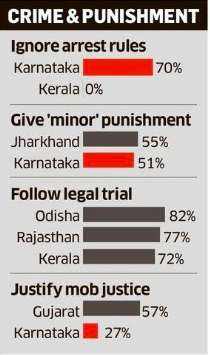Rise in ‘Baala Bhikatane’ (Child Begging) Cases in Karnataka
Background
- The ‘Baala Bhikatane’ (Child Begging) program, initiated by the Karnataka State Child Protection Commission, has been tackling child begging across major cities in the state.
- The initiative aims to rescue and rehabilitate children involved in begging.
- Rescued Child Beggars (Year-wise)
- 2021-22: 288
- 2022-23: 453
- 2023-24: 606
- Total: 1,347
Child Begging Cases (District-wise)
- Bengaluru Urban: 212
- Kalaburagi: 119
- Mysuru: 145
Key Observations
- Bengaluru has the highest number of child beggars (212 cases) followed by Mysuru (145) and Kalaburagi (119).
- Most children involved in begging belong to economically backward families and migrant communities.
- Child begging is prevalent near temples, mosques, traffic signals, and busy markets.
Reasons for Child Begging
- Poverty and lack of education.
- Forced begging by families or criminal groups.
Migrant labor families using children for begging.
Study on Policing in India: Arrest Procedures & Compliance
- Karnataka police are least likely to follow arrest procedures, with 70% not complying.
- Kerala police are the most likely to follow procedures, with 94% reporting full compliance.
Other Observations
- Bihar: 51% of police officers reported rarely or never following arrest procedures.
- Jharkhand: 43% reported non-compliance with arrest procedures.
The study highlights that police responses reflect perceptions of compliance rather than actual adherence to legal procedures.
March Sees 69% More Summer Rainfall in Karnataka
Key Highlights:
- Karnataka experienced 69% more rainfall in March than the usual average.
- Normal rainfall for the state is 8 cm, but this year it has reached 14.8 cm.
Rainfall Distribution Across Regions:
- Coastal Karnataka: 49% increase in rainfall.
Southern Inland Karnataka: Recorded 107% more rainfall, the highest increase in the state. - Northern Inland Karnataka: Received only a 5% increase in rainfall.
Highest Rainfall Recorded in Karnataka
- Navokshu (Kodagu) received the highest rainfall at 30 cm.
- Other notable rainfall data:
- Bailahongala – 4 cm
Shimoga (Hanchadakatte), Somwarpete, Bhagamandal, Harangi – 3 cm each
Internal Reservation in Karnataka: Fresh Survey & Cabinet Decision
Key Highlights
- The State government has decided to conduct a fresh survey of Scheduled Castes (SC) population in Karnataka within the next two months.
- This decision was taken in the Cabinet meeting based on the H.N. Nagamohan Das Commission’s interim report submitted to Chief Minister Siddaramaiah.
- Confusion in caste nomenclature (Adi Karnataka, Adi Dravida, Adi Andhra) is a major issue.
Understanding the Issue
- What is Internal Reservation?
- Internal reservation refers to sub-classification within Scheduled Castes (SCs) to equitably distribute the 17% reservation quota among various SC sub-groups.
- Need for a Fresh Survey
- The 2011 Census estimated Karnataka’s SC population at 1.04 crore, but it is now projected to be 1.25 to 1.30 crore.
H.N. Nagamohan Das Commission’s Four Key Recommendations
- Conduct a Fresh Survey to determine SC population and sub-caste distribution.
- Use Modern Technology to complete the survey within 30-40 days.
Legal and Historical Context of Internal Reservation
- Internal reservation has been debated for over three decades.
- In 2012, the A.J. Sadashiva Commission recommended a sub-quota formula, but it was opposed by Dalit Right communities due to discrepancies in population data.
- In August 2024, the Supreme Court upheld internal reservation if based on empirical data.
- Many states, including Andhra Pradesh, Punjab, Uttar Pradesh, Maharashtra, Bihar, and Tamil Nadu, have formed commissions to study internal reservation.





